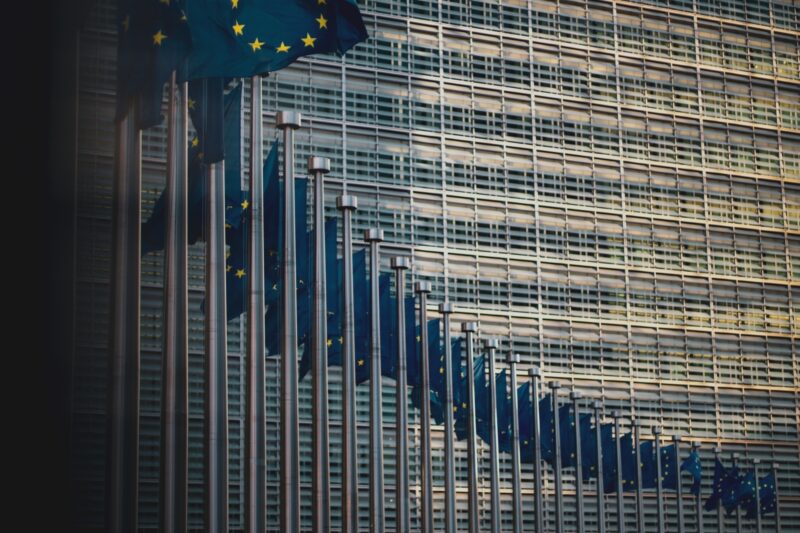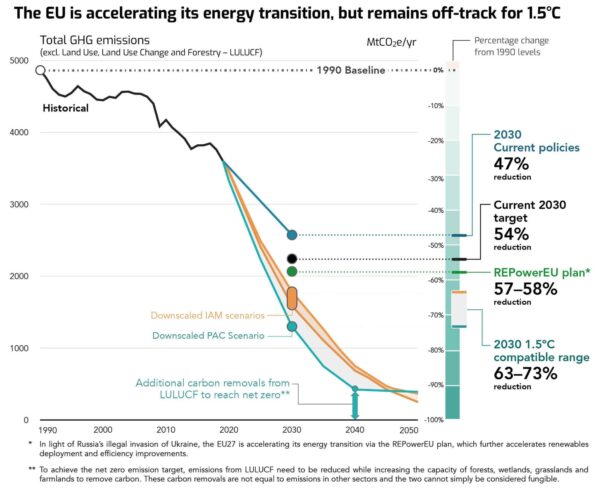1.5°C Pathways for the EU27: accelerating climate action to deliver the Paris Agreement
Authors
Neil Grant, Ryan Wilson, Aman Majid, Lara Welder, Jonas Hörsch, Claire Fyson, Bill Hare
Share

Global action remains insufficient to meet the Paris Agreement’s long-term temperature goal. Increasing the ambition of 2030 climate targets and accelerating emissions reductions in this decade are essential. This report presents technically feasible 1.5°C compatible energy and emissions pathways for the EU27 and assesses whether the EU’s current 2030 climate targets are aligned with limiting warming to 1.5°C.
The report finds that, to be 1.5°C compatible, the EU27 would need to cut its domestic emissions faster than currently planned. 1.5°C compatible pathways assessed in this report, and filtered to meet sustainability constraints, show that the EU27 can feasibly:
- Reduce its greenhouse gas (GHG) emissions between 63-73% below 1990 levels excl. landuse, land use change and forestry (LULUCF). Accounting for LULUCF, this corresponds to a 66-77% reduction by 2030, relative to 1990 levels
- Reach net zero GHG emissions between 2040-2045
- Limit the EU27’s total cumulative CO2 emissions to 11-22GtCO2 from 2020 until mid-century(incl. LULUCF)
The analysis therefore suggests that the EU27’s current Nationally Determined Contribution (NDC), which aims to cut emissions by 55% below 1990 levels by 2030 (incl. LULUCF), cannot be seen as compatible with 1.5°C.

The report also demonstrates how the EU27 could achieve these 1.5°C compatible benchmarks through a rapid transition to an efficient energy system powered by renewable energy sources. It focuses on two illustrative pathways, the HighRE scenario and the PAC scenario. The HighRE scenario is a downscaled version of an integrated assessment model pathway which relies on low-cost renewables to limit warming to 1.5°C while reducing reliance on bioenergy and carbon dioxide removal. The PAC scenario provides a bottom-up perspective on how the EU27+UK can reach absolute zero CO2 emissions by 2040. These pathways are produced by different methodologies, which gives a more robust assessment of 1.5°C compatible action for the EU27.
In these pathways, electricity provides 66-70% of final energy in 2050. There are also strong and sustained reductions in final energy demand, which means that by 2050, total energy demand in the EU27 can be up to 58% lower than in 2019. Overall, renewables provide 48-54% of final energy demand in 2030, rising to 92-100% of final energy by 2050.
Fossil fuels are rapidly displaced from the energy system in 1.5°C compatible pathways for the EU27. In the most ambitious pathways, coal is phased out of the energy system by the early 2030s, and oil/gas by 2040 at the latest. There is a particularly strong action in the power sector, where rapid deployment of wind and solar is the cornerstone of the energy transition. Key milestones for the power sector in these illustrative pathways include:
- Coal phased out of power generation by 2030 and fossil gas by the mid-2030s
- A transition to 100% fossil-free electricity by the mid-2030s
- A transition to 100% renewable electricity by 2050 at the latest
- Electricity generation more than doubling by 2050
It is clear that the EU27 can and must do more to align with the Paris Agreement’s 1.5°C target and provide global leadership on the climate crisis. By providing an updated NDC which aims to cut emissions by at least 66% (incl. LULUCF) by 2030, by committing to 100% fossil-free electricity by the mid-2030s, and by bringing forward the date of net zero GHG emissions by up to a decade, the EU27 can drive ambitious climate action and help keep 1.5°C alive.











